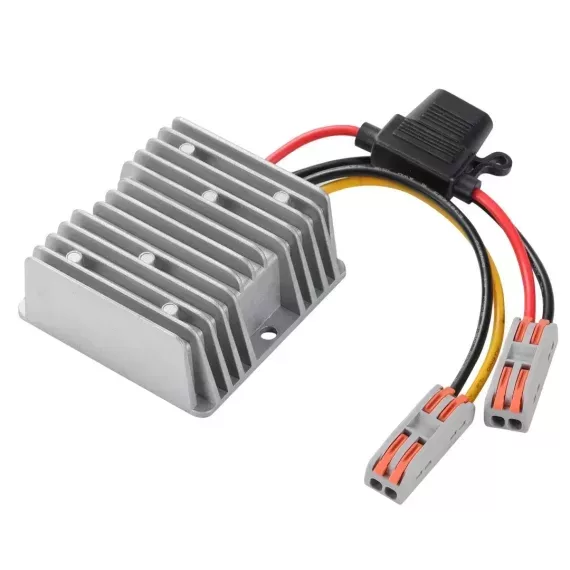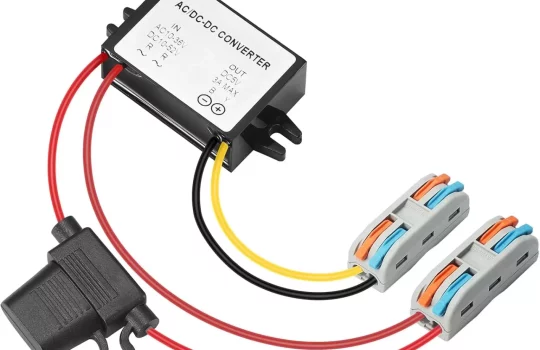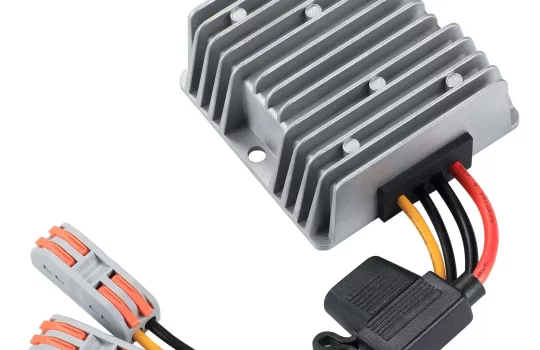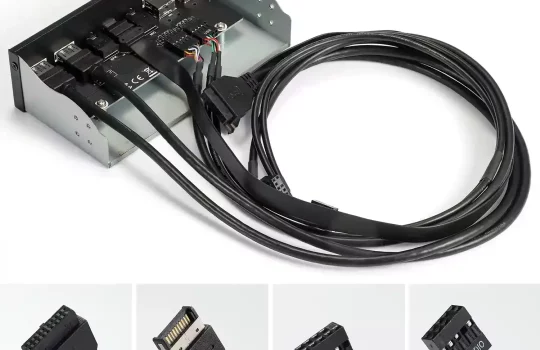When it comes to managing voltage in your electrical systems, the choice between a 24V to 12V DC-DC converter and a voltage regulator isn’t just a technical detail—it’s a decision that can impact the performance, efficiency, and longevity of your devices. But with so many options out there, how do you know which one is the right fit for your application?
If you’ve ever wondered about the differences between these two components and how they can affect your project, you’re in the right place. In this article, we’ll dive deep into the comparison between DC-DC converters and voltage regulators, breaking down their mechanics, use cases, advantages, and helping you choose the right solution for your specific needs. Let’s get started by exploring the basics, then work our way through the key differences, and ultimately help you make a more informed decision.
Understanding the Core Difference: How Do They Work?
Before we even get into why you might choose one over the other, it’s important to understand what these devices do and how they operate.
What is a DC-DC Converter?
A DC-DC converter is a type of power supply that transforms an input DC voltage into a different DC output voltage, either stepping it up (boost) or stepping it down (buck). For example, a 24V to 12V DC-DC converter will reduce 24V DC input to a stable 12V DC output.
DC-DC converters work using switching technology, which involves rapidly switching the input power on and off, and then using components like inductors and capacitors to filter and smooth the output voltage. This switching mechanism helps maintain high efficiency, often upwards of 90%, which is one of the primary reasons DC-DC converters are so popular in energy-sensitive applications.
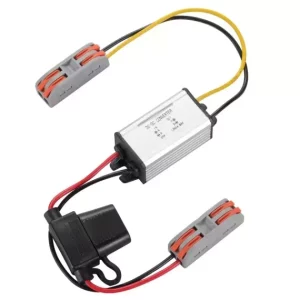
What is a Voltage Regulator?
On the other hand, a voltage regulator serves the same core purpose: maintaining a constant output voltage. However, it does so in a simpler way. There are two primary types:
- Linear Regulators: These maintain a stable output by dissipating the excess voltage as heat. This is a more straightforward and quieter method but comes at the cost of efficiency.
- Switching Regulators: These use similar switching principles to DC-DC converters but with a focus on providing a stable output voltage, usually with moderate efficiency.
Voltage regulators are typically used when stable and clean voltage is required, and the efficiency isn’t the most critical factor.
Key Differences to Consider:
Now that we know what each component does, let’s break down the most important differences between DC-DC converters and voltage regulators:
- Efficiency
- DC-DC Converters: These are highly efficient, often achieving 85-95% efficiency or higher. Since they use switching technology, they convert power without wasting much as heat, which makes them ideal for battery-powered applications where conserving energy is key.
- Voltage Regulators: Linear voltage regulators are less efficient, often delivering 50-70% efficiency due to their inherent design where excess voltage is wasted as heat. Switching regulators improve efficiency to about 80-90%, but they still don’t match the best DC-DC converters.
The Winner: DC-DC converters, especially when efficiency is a major concern.
- Simplicity & Design Complexity
- DC-DC Converters: These are more complex devices. They require a careful selection of components, including inductors, capacitors, and sometimes transformers, to ensure smooth operation and voltage regulation. These converters also require more careful circuit design, especially for higher power applications.
- Voltage Regulators: Linear regulators are incredibly simple. They have fewer components, which makes them easier to implement and cheaper to produce. Switching regulators, while still more complex than linear types, are generally simpler than full-fledged DC-DC converters.
The Winner: Voltage regulators, particularly linear regulators for simplicity and ease of use.
- Size and Form Factor
- DC-DC Converters: Due to the need for additional components like inductors and capacitors, DC-DC converters tend to be larger and bulkier than simple voltage regulators. However, smaller versions of converters are available for low-power applications.
- Voltage Regulators: Linear regulators, especially, are very compact, making them ideal for space-constrained applications like microcontrollers and low-power devices.
The Winner: Voltage regulators, particularly linear ones, for small and compact designs.
- Cost
- DC-DC Converters: These tend to be more expensive due to their complexity and the additional components required. Higher-efficiency converters, especially for more demanding applications, come at a premium price.
- Voltage Regulators: Linear regulators are among the cheapest components available for regulating voltage. Switching regulators are more expensive than linear versions but still cheaper than DC-DC converters in many cases.
The Winner: Voltage regulators, particularly linear ones, for cost-effectiveness.
- Applications & Use Cases
- DC-DC Converters: Given their efficiency, DC-DC converters are commonly used in battery-operated devices, electric vehicles, solar systems, and renewable energy setups where energy conservation is a top priority. They’re also ideal in systems where the input voltage fluctuates significantly but a stable output is required.
- Voltage Regulators: Voltage regulators, especially linear regulators, are used in low-power applications like sensors, microcontrollers, and RF systems, where noise-free and stable voltage is more important than efficiency. They are often seen in consumer electronics, audiophile equipment, and precision devices.
The Winner: Depends on the specific application needs. If energy efficiency and power management are key, go for DC-DC converters. If your system requires noise-free output at low power, choose voltage regulators.
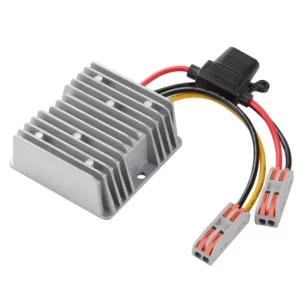
When to Choose a DC-DC Converter
- Energy Efficiency is Critical: When your application is battery-powered or you need to minimize energy loss, DC-DC converters are the way to go. For example, in electric vehicles or solar power systems, where maximizing available energy is essential, a 24V to 12V DC-DC converter would be ideal.
- Wide Input Voltage Range: If your input voltage can vary significantly (for example, in automotive applications where voltage fluctuates), a DC-DC converter can handle those changes and provide a stable output voltage.
- High Power Requirements: DC-DC converters are designed to handle high current and power demands, making them suitable for industrial equipment or power-hungry devices.
When to Choose a Voltage Regulator
- Low Power, Low Noise Applications: For systems where energy efficiency isn’t as critical and the cleanliness of the output voltage matters more, voltage regulators shine. If you’re working with sensitive electronics, audio equipment, or precision instruments, the low-noise characteristics of voltage regulators make them the perfect choice.
- Cost-Effective and Simple Designs: When working with simple circuits and a tight budget, voltage regulators are typically the best bet. They are inexpensive, easy to integrate, and require minimal design effort.
- Compact Systems: For small or portable devices where space is limited, linear voltage regulators are ideal due to their small form factor and straightforward implementation.
Final Thoughts: Making the Right Choice
When choosing between a 24V to 12V DC-DC converter and a voltage regulator, the decision comes down to your application’s specific needs. If you require high efficiency, power handling, and the ability to manage fluctuating input voltages, a DC-DC converter will be the optimal choice. However, if you’re working with low-power devices that require clean voltage with minimal noise, a voltage regulator (especially linear ones) is likely a better option.
By understanding the strengths and weaknesses of each component, you can make an informed decision and ensure your electrical system performs at its best. The right choice will not only improve the functionality of your project but also ensure long-term reliability and cost-effectiveness.
In this article, we’ve dug deep into the technical nuances and real-world applications of DC-DC converters and voltage regulators, offering you insights into when and why you should choose one over the other. Now, you have the knowledge to make the best choice for your next project—whether it’s an electric vehicle, a solar setup, or any other system requiring reliable voltage management.

